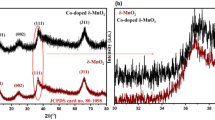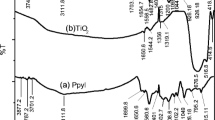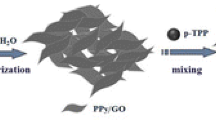Abstract
In spite of single nanomaterials, nanocomposites have come to be the superior modifying materials for electrochemical sensing. Herein, the highly sophisticated and sensitive voltammetric sensor of polypyrrole/cerium oxide/glassy carbon electrode (Ppyr/CeO2/GCE) has been fabricated for the electrochemical analysis of flupirtine maleate (FPM). Prior to the fabrication, the synthetic Ppyr/CeO2 material and its constituents viz., Ppyr and CeO2 were spectrally characterized by FTIR, XRD, and SEM to confirm the successful synthesis. After the fabrication of the Ppyr/CeO2/GCE sensor, it together with its corresponding forms i.e., CeO2/GCE and Ppyr/GCE including bare GCE was characterized by voltammetry and electrochemical impedance spectroscopy (EIS). The electrode characteristics such as charge transfer resistance, heterogeneous electron transfer (HET) rate constant, (\(k_{{{\text{eff}}}}^{0}\)) and surface area suggest that the designed electrochemical sensor has got the conductivity (sensitivity) par excellence as compared to CeO2/GCE, Ppyr/GCE and bare GCE. The fabricated probe after characterization was optimized for the detection of the FPM by voltammetry and found to show a direct correlation between the oxidation current and the FPM concentration varying from 100 ng mL−1 to 500 ng mL−1 having correlation coefficient (r2) of 0.9940. By measuring the calibration curve, the fabricated Ppyr/CeO2/GCE sensor was found to reach the minimum limit of detection (LOD) i.e., 26.76 ng mL−1 and minimum limit of quantification (LOQ) i.e., 89.20 ng mL−1, for FPM, thereby showing the sensitivity par excellence in terms of conductivity.
Graphic abstract

Fabrication of Ppyr/CeO2/GCE voltammetric sensor












Similar content being viewed by others
References
Zhang D, Song X, Su J (2014) Isolation, identification and characterization of novel process-related impurities in flupirtine maleate. J Pharm Biomed Anal 90:27–34
Lemmerhirt CJ, Rombach M, Bodtke A, Bednarski PJ, Link A (2015) Oxidation potentials of N-modified derivatives of the analgesic flupirtine linked to potassium KV7 channel opening activity but not hepatocyte toxicity. ChemMedChem 10(2):368–379
Bock C, Beirow K, Surur AS, Schulig L, Bodtke A, Bednarski PJ, Link A (2018) Synthesis and potassium KV7 channel opening activity of thioether analogues of the analgesic flupirtine. Org Biomol Chem 16(45):8695–8699
Surur AS, Beirow K, Bock C, Schulig L, Kindermann MK, Bodtke A, Siegmund W, Bednarski PJ, Link A (2019) Flupirtine analogues: explorative synthesis and influence of chemical structure on KV7.2/KV7.3 channel opening activity. Chem Open 8(1):41–44
Scheuch E, Methling K, Bednarski PJ, Oswald S, Siegmund W (2015) Quantitative LC–MS/MS determination of flupirtine, its N-acetylated and two mercapturic acid derivatives in man. J Pharm Biomed Anal 102:377–385
Surur AS, Bock C, Beirow K, Wurm K, Schulig L, Kindermann MK, Siegmund W, Bednarski PJ, Link A (2019) Flupirtine and retigabine as templates for ligand-based drug design of KV7.2/3 activators. Org Biomol Chem 17(18):4512–4522
Bock C, Surur AS, Beirow K, Kindermann MK, Schulig L, Bodtke A, Bednarski PJ, Link A (2019) Sulfide analogues of flupirtine and retigabine with nanomolar KV7.2/KV7.3 channel opening activity. ChemMedChem 14(9):952–964
Beitollahi H, Karimi-Maleh H, Khabazzadeh H (2008) Nanomolar and selective determination of epinephrine in the presence of norepinephrine using carbon paste electrode modified with carbon nanotubes and novel 2-(4-oxo-3-phenyl-3, 4 dihydro-quinazolinyl)-N′-phenyl-hydrazinecarbothioamide. Anal Chem 80(24):9848–9851
Tajik S, Taher MA, Beitollahi H (2014) Mangiferin DNA biosensor using double-stranded DNA modified pencil graphite electrode based on guanine and adenine signals. J Electroanal Chem 720:134–138
Soltani H, Beitollahi H, Hatefi-Mehrjardi AH, Tajik S, Torkzadeh-Mahani M (2014) Voltammetric determination of glutathione using a modified single walled carbon nanotubes paste electrode. Anal Bioanal Electrochem 6(1):67–79
Beitollahi H, Tajik S, Parvan H, Soltani H, Akbari A, Asadi MH (2014) Nanostructured based electrochemical sensor for voltammetric determination of ascorbic acid in pharmaceutical and biological samples. Anal Bioanal Electrochem 6(1):54–66
Motaghi MM, Beitollahi H, Tajik S, Hosseinzadeh R (2016) Nanostructure electrochemical sensor for voltammetric determination of vitamin C in the presence of vitamin B6: application to real sample analysis. Int J Electrochem Sci 11(9):7849–7860
Ganjali MR, Dourandish Z, Beitollahi H, Tajik S, Hajiaghababaei L, Larijani B (2018) Highly sensitive determination of theophylline based on graphene quantum dots modified electrode. Int J Electrochem Sci 13(3):2448–2461
Baghbamidi SE, Beitollahi H, Tajik S, Hosseinzadeh R (2016) Voltammetric sensor based on 1-benzyl-4-ferrocenyl-1H-[1, 2, 3]-triazole/carbon nanotube modified glassy carbon electrode; detection of hydrochlorothiazide in the presence of propranolol. Int J Electrochem Sci 11(12):10874–10883
Singh K, Nowotny J, Thangadurai V (2013) Amphoteric oxide semiconductors for energy conversion devices: a tutorial review. Chem Soc Rev 42(5):1961–1972
Nuraje N, Asmatulu R, Kudaibergenov S (2012) Metal oxide-based functional materials for solar energy conversion: a review. Curr Inorg Chem 2(2):124–146
Ren Y, Ma Z, Bruce PG (2012) Ordered mesoporous metal oxides: synthesis and applications. Chem Soc Rev 41(14):4909–4927
Tschöpe A, Sommer E, Birringer R (2001) Grain size-dependent electrical conductivity of polycrystalline cerium oxide: I: Experiments. Solid State Ionics 139(3–4):255–265
Wei Y, Li M, Fang B (2007) Fabrication of CeO2 nanoparticle modified glassy carbon electrode for ultrasensitive determination of trace amounts of uric acid in urine. Chin J Chem 25(11):1622–1626
Zhang D-E, Chen A-M, Wang M-Y, Gong J-Y, Zhang X-B, Li S-Z, Han G-Q, Ying A-L, Tong Z-W (2011) Solvothermal preparation of Ceo2 nanocubes and their catalytic properties. Funct Mater Lett 4(1):97–100
Wei Y, Li M, Jiao S, Huang Q, Wang G, Fang B (2006) Fabrication of CeO2 nanoparticles modified glassy carbon electrode and its application for electrochemical determination of UA and AA simultaneously. Electrochim Acta 52(3):766–772
Ansari S, Ansari MS, Dev N, Satsangee SP (2019) CeO2 nanoparticles based electrochemical sensor for an anti-anginal drug. Mater Today Proc 18(3):1210–1219
Peng H, Zhang L, Soeller C, Travas-Sejdic J (2009) Conducting polymers for electrochemical DNA sensing. Biomaterials 30(11):2132–2148
Vidal JC, Garcia-Ruiz E, Castillo JR (2003) Recent advances in electropolymerized conducting polymers in amperometric biosensors. Microchim Acta 143(2–3):93–111
Nambiar S, Yeow JTW (2011) Conductive polymer-based sensors for biomedical applications. Biosens Bioelectron 26(5):1825–1832
Xia L, Wei Z, Wan M (2010) Conducting polymer nanostructures and their application in biosensors. J Colloid Interface Sci 341(1):1–11
Ates M, Sarac AS (2009) Conducting polymer coated carbon surfaces and biosensor applications. Prog Org Coat 66(4):337–358
Hatchett DW, Josowicz M (2008) Composites of intrinsically conducting polymers as sensing nanomaterials Chem. Chem Rev 108(2):746–769
Trojanowicz M (2003) Application of conducting polymers in chemical analysis. Microchim Acta 143(2–3):75–91
Lange U, Roznyatovskaya NV, Mirsky VM (2008) Conducting polymers in chemical sensors and arrays. Anal Chim Acta 614(1):1–26
Li J, Wei W, Luo S (2010) A novel one-step electrochemical codeposition of carbon nanotubes-DNA hybrids and tiron doped polypyrrole for selective and sensitive determination of dopamine. Microchim Acta 171(1):109–116
Şen S, Gök A, Gülce H (2007) Novel Ni/polypyrrole and Cu/polypyrrole composites prepared in the presence of different acids: synthesis and investigation of thermal stability. J Appl Polym Sci 106(6):3852–3860
Rodriguez J (1997) Grande Hand Otero TF, Handbook of organic conducting molecules and polymers, vol 2. Wiley, Chichester, pp 415–468
Armes SP (1998) Colloidal dispersions of conducting polymers. In: Skotheim TA, Elsenbamer RL, Reynolds JR (eds) Handbook of conducting polymers, 2nd edn. Marcel Dekker Inc., New York, pp 423–435 [Chapter 17]
Sun D, Zhang Y, Wang F, Wu K, Chen J, Zhou Y (2009) Electrochemical sensor for simultaneous detection of ascorbic acid, uric acid and xanthine based on the surface enhancement effect of mesoporous silica. Sens Actuators B 141(2):641–645
Zhang ZH, Hu YF, Zhang HB, Luo LJ, Yao SZ (2010) Electrochemical layer-by-layer modified imprinted sensor based on multi-walled carbon nanotubes and sol–gel materials for sensitive determination of thymidine. J Electroanal Chem 644(1):7–12
Jain R, Sinha A, Khan AL (2016) Polyaniline–graphene oxide nanocomposite sensor for quantification of calcium channel blocker levamlodipine. Mater Sci Eng C 65(1):205–214
Jain R, Sinha A, Kumari N, Khan AL (2016) A polyaniline/graphene oxide nanocomposite as a voltammetric sensor for electroanalytical detection of clonazepam. Anal Methods 8(15):3034–3045
Jain R, Khan AL, Karolia P (2016) Electrocatalytic quantification of pantaprazole. J Electrochem Soc 163(8):H633–H638
Wooster TJ, Bond AM (2003) Ion selectivity obtained under voltammetric conditions when a TCNQ chemically modified electrode is presented with aqueous solutions containing tetraalkylammonium cations. Analyst 128(11):1386–1390
Wooster TJ, Bond AM, Honeychurch MJ (2003) An analogy of an ion-selective electrode sensor based on the voltammetry of microcrystals of tetracyanoquinodimethane or tetrathiafulvalene adhered to an electrode surface. Anal Chem 75(3):586–592
Cano M, Rodriguez-Amaro R, Romero AJF (2008) Use of Butler-Volmer treatment to assess the capability of the voltammetric ion sensors: application to a PPy/DBS film for cations detection. Electrochem Commun 10(2):190–194
Cano M, Rodriguez-Amaro R, Romero AJF (2008) A new method based on the Butler−Volmer formalism to evaluate voltammetric cation and anion sensors. J. Phys. Chem. B 112(49):5596–15603
Bora C, Dolui SK (2014) Interfacial synthesis of polypyrrole/graphene composites and investigation of their optical, electrical and electrochemical properties. Polym Int 63(8):1439–1446
Khan AL, Jain R (2018) Polypyrrole/titanium dioxide nanocomposite sensor for the electrocatalytic quantification of sulfamoxole. Ionics 24(8):2473–2488
Sultan A, Anwer T, Ahmad S, Mohammad F (2016) Preparation, characterization, and dynamic adsorption–desorption studies on polypyrrole encapsulated TiO2 nanoparticles. J Appl Polym Sci 133(20):43411
Saravanan C, Shekhar RC, Palaniappan S (2006) Synthesis of polypyrrole using benzoyl peroxide as a novel oxidizing agent. Macromol Chem Phys 207(3):342–348
Su PG, Huang LN (2007) Humidity sensors based on TiO2 nanoparticles/polypyrrole composite thin films Sens. Sens Actuators B 123(1):501–507
Ho C, Yu JC, Kwang T, Mak AC, Lai S (2005) Morphology-controllable synthesis of mesoporous CeO2 nano- and microstructures. Chem Mater 17(17):4514–4522
Farahmandjou M, Zarinkamar M, Firoozabadi TP (2016) Synthesis of cerium oxide (CeO2) nanoparticles using simple CO-precipitation method. Rev Mex Fis 62(5):496–499
Niu F, Zhang D, Shi L, He X, LiHMai H, Yan T (2009) Facile synthesis, characterization and low-temperature catalytic performance of Au/CeO2 nanorods. Mater Lett 63(24–25):2132–2135
Palard M, Balencie J, Maguer A, Hochepied JF (2010) Effect of hydrothermal ripening on the photoluminescence properties of pure and doped cerium oxide nanoparticles. Mater Chem Phys 120(1):79–88
Huang CL, Matijevic E (1995) Coating of uniform inorganic particles with polymers: III. Polypyrrole on different metal oxides. J Mater Res 10(5):1327–1336
Heydarnezhad HR, Pourabbas B (2013) One-step synthesis of conductive ceria/polypyrrole nanocomposite particles via photo-induced polymerization method. J Mater Sci Mater Electron 24(11):4378–4385
Rezaei B, Damiri S (2008) Voltammetric behavior of multi-walled carbon nanotubes modified electrode-hexacyanoferrate(II) electrocatalyst system as a sensor for determination of captopril. Sens Actuator B 134(1):324–331
Nambiar SR, Aneesh PK, Rao TP (2013) Ultrasensitive voltammetric determination of catechol at a gold atomic cluster/poly(3,4-ethylenedioxythiophene) nanocomposite electrode. Analyst 138(17):5031–5038
Sun JY, Huang KJ, Zhao SF, Fan Y, Wu ZW (2011) Direct electrochemistry and electrocatalysis of hemoglobin on chitosan-room temperature ionic liquid-TiO2-graphene nanocomposite film modified electrode. Bioelectrochemistry 82(2):125–130
Bard AJ, Faulkner LR (1980) Electrochemical methods: fundamentals and applications, 2nd edn. Wiley, New York
Nicholson RS (1965) Theory and application of cyclic voltammetry for measurement of electrode reaction kinetics. Anal Chem 37(11):1351–1355
Brownson DAC, Kelly PJ, Banks CE (2015) In situ electrochemical characterisation of graphene and various carbon-based electrode materials: an internal standard approach. RSC Adv 5(47):37281–37286
Brownson DAC, Varey SA, Hussain F, Haigh SJ, Banks CE (2014) Electrochemical properties of CVD grown pristine graphene: monolayer- vs. quasi-graphene. Nanoscale 6(3):1607–1621
Banks CE, Compton RG, Fisher AC, Henley IE (2004) The transport limited currents at insonated electrodes. Phys Chem Chem Phys 6(12):3147–3152
Brownson DAC, Kampouris DK, Banks CE (2012) Graphene electrochemistry: fundamental concepts through to prominent applications. Chem Soc Rev 41(21):6944–6976
Brownson DAC, Banks CE (2014) The handbook of graphene electrochemistry. Springer, London
Lavagnini I, Antiochia R, Magno F (2004) An extended method for the practical evaluation of the standard rate constant from cyclic voltammetric data. Electroanalysis 16(6):505–506
Griffiths K, Dale C, Hedley J, Kowal MD, Kaner RB, Keegan N (2014) Laser-scribed graphene presents an opportunity to print a new generation of disposable electrochemical sensors. Nanoscale 6(22):13613–13622
McCreery RL, McDermott MT (2012) Comment on electrochemical kinetics at ordered graphite electrodes. Anal Chem 84(5):2602–2605
Bosch-Navarro C, Laker ZPL, Rourkeb JP, Wilson NR (2015) Reproducible, stable and fast electrochemical activity from easy to make graphene on copper electrodes. Phys Chem Chem Phys 17(44):29628–29636
Zoski CG (2007) Handbook of electrochemistry. Elsevier, New York
Randviir EP (2018) A cross examination of electron transfer rate constants for carbon screen-printed electrodes using electrochemical impedance spectroscopy and cyclic voltammetry. Electrochim Acta 286:179–186
Guan H, Fan LZ, Zhang H, Qu X (2010) Polyaniline nanofibers obtained by interfacial polymerization for high-rate supercapacitors. Electrochim Acta 56(2):964–968
Lien TTN, Lam TD, An VTH, Hoang TV, Quang DT, Khieu DQ, Tsukahara T, Lee YH, Kim JS (2010) Multi-wall carbon nanotubes (MWCNTs)-doped polypyrrole DNA biosensor for label-free detection of genetically modified organisms by QCM and EIS. Talanta 80(3):1164–1169
Zhu J, Chen M, Qu H, Zhang X, Wei H, Luo Z, Colorado HA, Wei S, Guo Z (2012) Interfacial polymerized polyaniline/graphite oxide nanocomposites toward electrochemical energy storage. Polymer 53(25):5953–5964
Wei H, Zhu J, Wu S, Wei S, Guo Z (2013) Electrochromic polyaniline/graphite oxide nanocomposites with endured electrochemical energy storage. Polymer 54(7):1820–1831
Nicholson RS, Shain I (1964) Theory of stationary electrode polarography single scan and cyclic methods applied to reversible, irreversible, and kinetic systems. Anal Chem 36(4):706–723
Compton RG, Batchelor-McAuley C, Dickinson EJF (2012) Understanding voltammetry: problems and solutions. Imperial College Press, London
Zanello P, Nervi C, de Biani FF (2011) Inorganic electrochemistry: theory, practice and application. Royal Society of Chemistry Publishing, Cambridge
Kissinger PT, Heineman WH (1996) Laboratory techniques in electroanalytical chemistry, 2nd edn. Marcel Dekker, New York
Chrzescijanska E, Wudarska E, Kusmierek E, Rynkowski J (2014) Study of acetylsalicylic acid electroreduction behavior at platinum electrode. J Electroanal Chem 713:17–21
Timbola AK, Souza CD, Pizzolatti SC, Spinelli A (2007) Electro-oxidation of rutin in the presence of p-toluenesulfinic acid. J Appl Electrochem 37(5):617–624
Abrams SML, Baker LRI, Crome P, White AST, Johnston A, Ankier SI, Warrington SJ, Turner P, Niebch G (1988) Pharmacokinetics of flupirtine in elderly volunteers and inpatients with moderate renal impairment. Postgrad Med J 64:361–363
Kathirvel S, Sujatha R, Pandit MR, Suneetha A (2013) Stress Degradation studies on flupirtine maleate using stability-indicating RP-HPLC method. Chromatogr Res Int 2013:1–6
Zhao YM, Zheng ZB, Li S (2016) Quantification of flupirtine maleate polymorphs using X-ray powder diffraction. Chin Chem Lett 27(11):1666–1672
Hofstetter RK, Hasan M, Fassauer GM, Bock C, Surur AS, Behnisch S, Grathwol CW, Potlitz F, Oergel T, Siegmund W, Link A (2019) Simultaneous quantification of acidic and basic flupirtine metabolites by supercritical fluid chromatography according to European Medicines Agency validation. J Chromatogr A. https://doi.org/10.1016/j.chroma.2019.04.067
Shah U, Kavad M, Raval M (2013) Development and validation of spectrofluorimetric method for the estimation of Flupirtine maleate in bulk drug and pharmaceutical dosage form. Anal Chem 13(3):102–106
Krasnykh LM, Rodina TA, Melnikov ES, Vasilenko GF, Smirnov VV, Sokolov AV, Arkhipov VV (2018) Flupirtine determination in human blood plasma by HPLC with mass-spectrometric detection and its application to pharmacokinetic studies. Pharm Chem J 51(12):1123–1128
Acknowledgements
The authors are highly thankful to the school of studies in chemistry Jiwaji University Gwalior to provide us all the essential services.
Author information
Authors and Affiliations
Corresponding authors
Additional information
Publisher's Note
Springer Nature remains neutral with regard to jurisdictional claims in published maps and institutional affiliations.
Electronic supplementary material
Below is the link to the electronic supplementary material.
Rights and permissions
About this article
Cite this article
Khan, A.L., Dhanjai & Jain, R. Fabrication and optimization of polypyrrole/cerium oxide/glassy carbon sensing platform for the electrochemical detection of flupirtine. J Appl Electrochem 50, 655–672 (2020). https://doi.org/10.1007/s10800-020-01418-z
Received:
Accepted:
Published:
Issue Date:
DOI: https://doi.org/10.1007/s10800-020-01418-z




